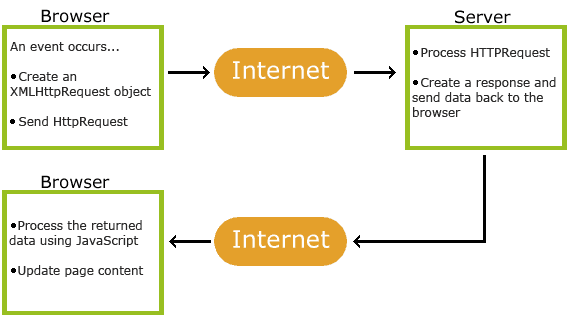AJAX
AJAX
AJAX is a developer's dream because you can:
- Read data from a web server - after the page has loaded
- Update a web page without reloading the page
- Send data to a web server - in the background
AJAX is a developer's dream because you can:
- Read data from a web server - after the page has loaded
- Update a web page without reloading the page
- Send data to a web server - in the background
What Is AJAX?
AJAX = Asynchronous JavaScript And XML.
AJAX just uses a combination of:
- A browser built-in
XMLHttpRequest object (to request data from a web server) - JavaScript and HTML DOM (to display or use the data)
AJAX is a misleading name. AJAX applications might use XML to transport data, but it is equally common to transport data as plain text or JSON text.AJAX allows web pages to be updated asynchronously by exchanging data with a web server behind the scenes. This means that it is possible to update parts of a web page, without reloading the whole page.
AJAX = Asynchronous JavaScript And XML.
AJAX just uses a combination of:
- A browser built-in
XMLHttpRequestobject (to request data from a web server) - JavaScript and HTML DOM (to display or use the data)
AJAX allows web pages to be updated asynchronously by exchanging data with a web server behind the scenes. This means that it is possible to update parts of a web page, without reloading the whole page.
How AJAX Works

- An event occurs in a web page (the page is loaded, a button is clicked)
- An XMLHttpRequest object is created by JavaScript
- The XMLHttpRequest object sends a request to a web server
- The server processes the request
- The server sends a response back to the web page
- The response is read by JavaScript
- Proper action (like page update) is performed by JavaScript
The keystone of AJAX is the XMLHttpRequest object.
- An event occurs in a web page (the page is loaded, a button is clicked)
- An XMLHttpRequest object is created by JavaScript
- The XMLHttpRequest object sends a request to a web server
- The server processes the request
- The server sends a response back to the web page
- The response is read by JavaScript
- Proper action (like page update) is performed by JavaScript
The keystone of AJAX is the XMLHttpRequest object.
Access Across Domains
For security reasons, modern browsers do not allow access across domains.
This means that both the web page and the XML file it tries to load must be located on the same server.
The examples on W3Schools all open XML files located on the W3Schools domain.
If you want to use the example above on one of your own web pages, the XML files you load must be located on your own server.
For security reasons, modern browsers do not allow access across domains.
This means that both the web page and the XML file it tries to load must be located on the same server.
The examples on W3Schools all open XML files located on the W3Schools domain.
If you want to use the example above on one of your own web pages, the XML files you load must be located on your own server.